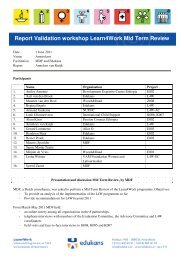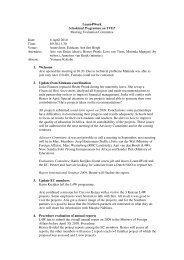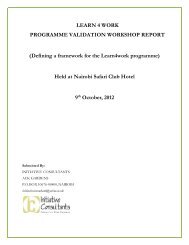DRAFT TECHNICAL AND VOCATIONAL EDUCATION AND ...
DRAFT TECHNICAL AND VOCATIONAL EDUCATION AND ...
DRAFT TECHNICAL AND VOCATIONAL EDUCATION AND ...
You also want an ePaper? Increase the reach of your titles
YUMPU automatically turns print PDFs into web optimized ePapers that Google loves.
20<br />
Excerpt No. 3: Catering<br />
It is very disappointing to note that NVTI Grade I and II trainees don’t know<br />
basic things like using a metal spoon in stirring in a metal bowl. They are so<br />
deficient that Landing Restaurant has made it a policy not to accept them for<br />
attachment.<br />
Excerpt No. 4: Building Construction<br />
The trainees don’t know how to read drawings because the trainees claim that<br />
they are not taught in schools. The trainees don’t know markings and also<br />
don’t know how to make profile. Other areas that trainees are lacking are<br />
block laying, plastering and training institution have to do more work on<br />
finishing touches.<br />
Excerpt No. 5: Tile Laying<br />
I found out that all those working on Tile Laying on the construction site are<br />
from Togo and talked to some of them. He says that sub-contractors come to<br />
Togo to recruit them. When they complete their assignment, they go back to<br />
Togo. When I asked the Supervisor why they prefer to recruit people from<br />
Togo for tile laying in Ghana, he said that Ghanaians don’t accept what they<br />
pay them per square metre. The Togolese will accept the terms, and do the<br />
work well on time also.<br />
The use of Competency-Based Training (CBT) approaches in TVET has been seen as the<br />
main way of correcting the mismatch and is entrenched in the national TVET policy.<br />
Structured and universal industrial attachment (or work-based learning) is another approach<br />
that has been embraced by training institutions and industry as a way of bridging the supplydemand<br />
mismatch, and negotiations as well as pilot studies are being undertaken to formalize<br />
industrial attachment.<br />
The TVET community has been sensitized to the need for tracer studies and the broader<br />
concept of monitoring post-graduation experiences of TVET graduates but the resources and<br />
capacity for execution are generally lacking. This study landed on only one tracer study<br />
conducted by NVTI with technical and financial assistance of JICA. Some highlights of the<br />
findings and conclusions of the tracer study (Nakanishi, 2006) are as follows:<br />
(a) In reality, “it is very difficult for them [trainee graduates] to find a permanent job, a parttime<br />
job, or a temporary job.”<br />
(b) 63.7% of respondents [500] were able to start a new business less than 6 months after<br />
training; 56.9% of those self-employed employ from one to five employees with a<br />
maximum of 25 employees.<br />
(c) About one out of four (25%) want to become an entrepreneur instead of being employed;<br />
(d) 50% of those interviewed said financial problems were the most difficult when they<br />
started self-employment; next was how to obtain efficient and useful tools or machinery.<br />
41% said what they needed were tools or machinery and 38% needed financial assistance.<br />
(e) As many as 65.5% gave vague answers about career advice. Career advice seems to be a<br />
very difficult question for Ghanaians and that means that “vocational education is not so<br />
familiar to parents, relatives, or superiors.”<br />
(f) Labour force demand for the manufacturing sector is weak. The service sector, especially<br />
the whole and retail sectors are growing.<br />
One significant recommendation made by Nakanishi (2006) was that “as the labour market is<br />
difficult, it is important for trainees to decide what they want to do after training as soon as<br />
possible.” This means that trainees or students should be made aware of the realities of the







